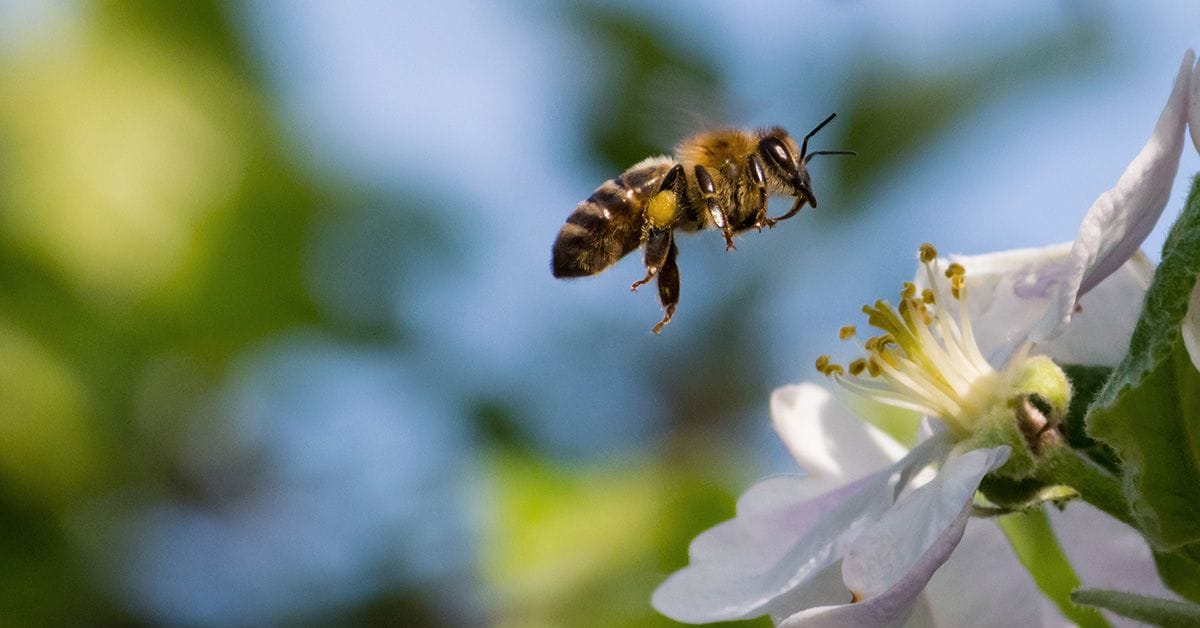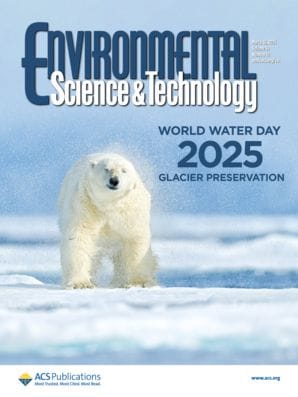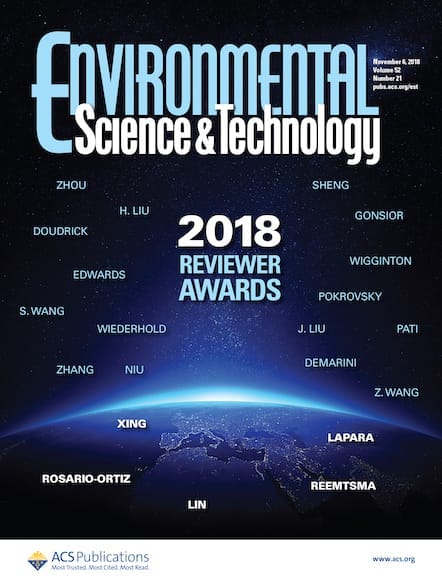A recent study reveals the hidden dangers of neonicotinoid pesticides on honeybee colonies, with effects on foraging efficiency and overall health.

Neonicotinoids are a class of synthetic insecticides that are heavily used in agriculture for crop protection. These systemic chemicals are absorbed by the crop plant and move through its tissues, ultimately killing pests—but they also end up in pollen and nectar, harboring residues above safety thresholds and posing a risk to harmless pollinators and other non-target insects.1 In 2018, the EU banned the outdoor use of neonicotinoids due to concerns around bee safety.2 In the U.S., several states have placed severely restrictive bans on certain types of neonicotinoids, but they continue to be widely used as pesticides in U.S. agriculture.3
While many insects are more passive pollinators—inadvertently moving pollen between flowers as they stop to drink nectar—bees are unique in actively gathering protein-rich pollen to use as the main food source for their hive’s larvae.4 More than one-third of global crops depend on bee pollination, but there is strong evidence that neonicotinoids can impact honeybee foraging,5 with subsequent effects on colony survival. Exposed bees take longer to complete foraging trips, ultimately resulting in lower pollen yields.6 They have also been shown to experience olfactory inhibition and cognitive difficulties.7,8 Previous studies have identified significant changes in individual behaviors, but gaps remain in establishing a clear link between these effects and overall foraging performance at the colony level.
Researchers in Germany set out to answer this by asking how the sublethal effects observed for individual bees translate into the colony’s ability to forage as a collective unit.9 They provided sugar solutions to eight colonies of free-flying honeybees in an agricultural landscape. Four colonies were fed a solution containing a sublethal dose of the neonicotinoid imidacloprid, and the four control colonies were given only the simple sugar solution. Over 11 consecutive days, the team observed daily colony-level foraging activities using AI-based monitoring technology. The authors also leveraged BEEHAVE, a mechanistic simulation model, to understand the mechanisms underlying their findings.10 The model links in-hive dynamics with land use in the surrounding landscape as well as weather conditions that could impact honeybee foraging.

Reduced Honeybee Pollen Foraging under Neonicotinoid Exposure: Exploring Reproducible Individual and Colony Level Effects in the Field Using AI and Simulation
DOI: 10.1021/acs.est.4c13656
Their results, published in Environmental Science & Technology, showed that individual exposed bees spent longer on pollen foraging trips, went out less often, and were prone to drifting—likely due to impaired cognitive function and altered metabolism. These behavioral changes at the individual level corroborated previous model predictions. At the colony level, the reduced number of returning pollen foragers was directly associated with neonicotinoid exposure. This work builds upon and further confirms their earlier findings published in 2019, in which they equipped bees with RFID tags to track their lifetime flight behavior.11 Results of the prior study showed that traces of neonicotinoid exposure at the larval stage caused bees to begin foraging at a younger age and perform fewer orientation flights, overall reducing lifetime foraging by 28%. “We were surprised that we could replicate the findings of our first field experiment in 2019,” says researcher Silvio Knaebe in a recent press release. “Honeybee colony behavior varies so much that statistically significant effects are difficult to detect.”
By integrating experimental studies with computer simulations, the researchers were able to successfully see how sublethal effects seen in individual foragers extend to the colony level, influencing efficiency, resource distribution, and overall colony dynamics. "To the best of our knowledge, the current work is the first to link effects observed at the individual level to those at the colony level in honeybees under pesticide exposure, which has implications for future pesticide risk assessment," note the authors in their article.
Explore Related Articles from ACS Publications
Bee Pollinator Mortality Due to Pesticide-Laden Particulate Matter from Beef Cattle Feedyards
Frank B Green, Eric M Peterson, Amanda D Emert, Seenivasan Subbiah, and Philip N Smith*
DOI: 10.1021/acs.est.3c03135
Computational Modeling Oriented Substructure Splicing Application in the Identification of Thiazolidine Derivatives as Potential Low Honeybee Toxic Neonicotinoids
Cong Zhou, Yijin Kong, Huihui Zhang, Na Zhai, Zhong Li, Xuhong Qian, Zewen Liu*, and Jiagao Cheng*
DOI: 10.1021/acs.jafc.4c00461
Neonicotinoids might harm butterflies too
Max Barnhart
DOI: 10.1021/cen-10220-scicon4
Leveraging In Silico Structure–Activity Models to Predict Acute Honey Bee (Apis mellifera) Toxicity for Agrochemicals
Max Sharifi*, Gyan P. Harwood, Melissa Harris, Drew M. Patel, Elizabeth Collison, and Tamara Lunsman
DOI: 10.1021/acs.jafc.4c02518
Bee Products: An Emblematic Example of Underutilized Sources of Bioactive Compounds
Francesca Giampieri, Jose Luis Quiles, Danila Cianciosi, Tamara Yuliett Forbes-Hernández, Francisco Josè Orantes-Bermejo, José Miguel Alvarez-Suarez*, and Maurizio Battino*
DOI: 10.1021/acs.jafc.1c05822
Rational Design of Triazinone Derivatives with Low Bee Toxicity Based on the Binding Mechanism of Neonicotinoids to Apis mellifera
Xingxing Lu, Zhiyang Jiang, Huan Xu, Xiaoming Zhang, Yufan Lin, Shixiang Pan, Yimeng Zhang, Yan Liu, Yinliang Wang, Xuesheng Li, Hongxia Duan, Xinling Yang*, and Yun Ling*
DOI: 10.1021/acs.jafc.4c00679
Determination of Pesticides in Bee Pollen: Validation of a Multiresidue High-Performance Liquid Chromatography-Mass Spectrometry/Mass Spectrometry Method and Testing Pollen Samples of Selected Botanical Origin
Rita Végh, Csilla Sörös, Nándor Majercsik, and László Sipos*
DOI: 10.1021/acs.jafc.1c06864
References
- Erickson, B. E. More evidence shows neonicotinoids harm bees. C&EN; June 29, 2017; 95, 27, 14.
- Neonicotinoids; European Commission, 2025. https://food.ec.europa.eu/plants/pesticides/approval-active-substances-safeners-and-synergists/renewal-approval/neonicotinoids_en.
- Coon, N. Buzzing Dangers: The Impact of Neonicotinoid Pesticides on Pollinators and the Global Economy. Harvard International Review, September 2, 2024.
- Spivak, M. et al. The Plight of the Bees. Environ. Sci. Technol. 2011, 45, 1, 34–38.
- van der Sluijs, J. P. et al. Neonicotinoids, bee disorders and the sustainability of pollinator services. Curr. Opin. Environ. Sustain. 2013, 5, 3, 293–305.
- Tison, L. et al. Honey Bees’ Behavior Is Impaired by Chronic Exposure to the Neonicotinoid Thiacloprid in the Field. Environ. Sci. Technol. 2016, 50, 13, 7218–7227.
- Liu, S. et al. Enantioselective Olfactory Effects of the Neonicotinoid Dinotefuran on Honey Bees (Apis mellifera L.). J. Agric. Food Chem. 2019, 67, 43, 12105–12116
- Fischer, J. et al. Neonicotinoids Interfere with Specific Components of Navigation in Honeybees. PLoS One 2014, 9, 3, e9136.
- Wang, M. et al. Reduced Honeybee Pollen Foraging under Neonicotinoid Exposure: Exploring Reproducible Individual and Colony Level Effects in the Field Using AI and Simulation. Environ. Sci. Technol. 2025, 59, 10, 4883–4892.
- https://beehave-model.net/
- Colin, T. et al. Traces of a Neonicotinoid Induce Precocious Foraging and Reduce Foraging Performance in Honey Bees. Environ. Sci. Technol. 2019, 53, 14, 8252–8261.
